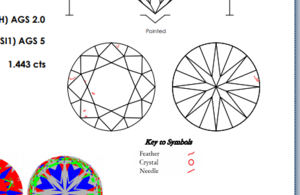- Joined
- Apr 10, 2018
- Messages
- 22
Hello everyone!
With the help of pricescope community, I bought an ACA diamond with wf's elegant solitaire setting last week. The ring is being made by wf right now. Last night I was bored and looked at the AGS certificate of the diamond I purchased. And I realized that the primary inclusion is feather on the girdle, which makes me a bit nervous because I remember reading somewhere saying feather on girdle can make the diamond chip easier. Is this a valid concern?
https://www.whiteflash.com/loose-diamonds/round-cut-loose-diamond-3970272.htm

With the help of pricescope community, I bought an ACA diamond with wf's elegant solitaire setting last week. The ring is being made by wf right now. Last night I was bored and looked at the AGS certificate of the diamond I purchased. And I realized that the primary inclusion is feather on the girdle, which makes me a bit nervous because I remember reading somewhere saying feather on girdle can make the diamond chip easier. Is this a valid concern?
https://www.whiteflash.com/loose-diamonds/round-cut-loose-diamond-3970272.htm





300x240.png)